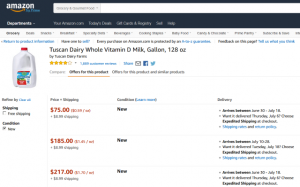Ever since Amazon.com announced it was acquiring Whole Foods earlier this week, the pundits have been jumping on the story, each one theorizing about Amazon’s motivations for the acquisition.

Some guesses make more sense, in particular, that Amazon wants to expand its grocery business. Others might leave you scratching your head, like the theory that Amazon wants to be more like Walmart.
Upon closer analysis, however, even the more popular theories have weaknesses, leaving us to wonder whether Amazon is essentially taking a $13 billion crap shoot – or making the biggest blunder of CEO Jeff Bezos’ career.
Peeling Back the Layers of the Whole Foods Onion
Our starting point: the official Amazon party line. “Millions of people love Whole Foods Market because they offer the best natural and organic foods, and they make it fun to eat healthy,” crows Bezos in the official Amazon press release. “Whole Foods Market has been satisfying, delighting and nourishing customers for nearly four decades – they’re doing an amazing job and we want that to continue.”
Bezos is clearly playing his cards close to the vest here, as he is saying nothing that would indicate why a global ecommerce leader would be interested in a supermarket chain. In fact, this statement appears so baldly disingenuous that one wonders whether a committee of PR wonks actually wrote it, rather than Bezos himself.
Nevertheless, the most likely explanation for the acquisition is that Amazon wishes to expand its grocery business – not simply by adding bricks-and-mortar supermarkets, but by expanding its core ecommerce efforts in this category.
The question then is: why Whole Foods, rather than a more mainstream supermarket chain like Kroger or Albertson’s? After all, Whole Foods’ business model is fundamentally broken in many ways: its ‘whole paycheck’ prices are too high, its selection is poor, and many of its products are based on quackery, targeting a gullible customer base who believes, for example, homeopathy is something other than pure nonsense.
Read the entire article at https://www.forbes.com/sites/jasonbloomberg/2017/06/23/amazons-whole-foods-strategy-its-not-what-you-think/.
Intellyx publishes the Agile Digital Transformation Roadmap poster, advises companies on their digital transformation initiatives, and helps vendors communicate their agility stories. As of the time of writing, none of the organizations mentioned in this article are Intellyx customers. Image credit: Jason Bloomberg, from Amazon.com.



